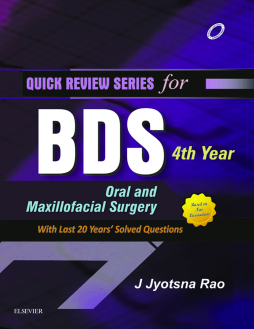
Additional Information
Book Details
Abstract
QRS for BDS 4th Year - E-Book
Table of Contents
| Section Title | Page | Action | Price |
|---|---|---|---|
| Front cover | Cover | ||
| Quick Review Series for BDS 4th Year Oral and Maxillofacial Surgery | iii | ||
| Copyright page | iv | ||
| Dedication | v | ||
| Foreword | vii | ||
| Preface | ix | ||
| Acknowledgements | xi | ||
| Table of contents | xiii | ||
| I Topic Wise Solved Questionsof Previous Years | 1 | ||
| Topic 1 Introduction to oral and maxillofacial surgery | 3 | ||
| Long essays | 3 | ||
| Disinfectants | 3 | ||
| Antiseptics | 3 | ||
| i. Alcohol | 4 | ||
| Advantages | 4 | ||
| Disadvantages | 4 | ||
| ii. Aldehyde compounds | 4 | ||
| a. Formaldehyde | 4 | ||
| b. Glutaraldehyde | 4 | ||
| iii. Chlorines | 4 | ||
| iv. Quaternary ammonium compounds | 4 | ||
| Uses | 5 | ||
| v. Phenolic compounds | 5 | ||
| Antiseptics | 5 | ||
| i. Alcohols | 5 | ||
| ii. Quaternary ammonium compounds | 5 | ||
| iii. Iodophor compounds | 5 | ||
| Halogens | 5 | ||
| Iodine | 5 | ||
| iv. Chlorhexidine | 5 | ||
| v. Hexachlorophene compounds | 5 | ||
| Hexachlorophene | 5 | ||
| Formaldehyde gas | 5 | ||
| Beta-propiolactone (BPL) | 5 | ||
| Testing of disinfectant | 5 | ||
| Rideal-Walker test | 5 | ||
| Chick-Martin test | 6 | ||
| i. Operating room procedures | 6 | ||
| Fumigation of operating room | 6 | ||
| Relative humidity (RH) | 6 | ||
| Temperature | 6 | ||
| Antiseptic environment | 6 | ||
| Airflow | 6 | ||
| ii. Hand scrub techniques | 7 | ||
| Hand disinfectants | 7 | ||
| Gloving | 7 | ||
| iii. Preparation of the surgical site | 7 | ||
| Draping the patient | 7 | ||
| Disposable items | 8 | ||
| Preoperative gingival/periodontal care | 8 | ||
| Use of antimicrobial mouth rinse | 8 | ||
| Use of antibiotic prophylaxis | 8 | ||
| Short essays | 8 | ||
| Sterilization | 8 | ||
| Disinfection | 8 | ||
| Various physical methods used in sterilization are as follows: | 8 | ||
| Autoclave | 8 | ||
| Mode of action of an autoclave | 8 | ||
| Uses | 8 | ||
| Advantages | 8 | ||
| Disadvantages | 9 | ||
| Effective sterilization in an autoclave depends upon | 9 | ||
| Hot air oven or dry heat sterilizers | 9 | ||
| a. The static-air type | 9 | ||
| b. The forced-air type | 9 | ||
| Advantages of dry heat sterilizers include | 9 | ||
| Disadvantages of dry heat sterilizers include | 9 | ||
| Patients suffering from acute illnesses | 9 | ||
| Healthy carriers | 10 | ||
| a. Convalescent carriers | 10 | ||
| Asymptomatic carriers | 10 | ||
| Pathogen | 10 | ||
| Susceptible host | 10 | ||
| Microorganisms | 10 | ||
| Short notes | 10 | ||
| Sterilization | 10 | ||
| Disinfection | 10 | ||
| Principle of an autoclave | 10 | ||
| Advantages | 11 | ||
| Disadvantages | 11 | ||
| Physical agents | 11 | ||
| Chemical agents | 11 | ||
| Antiseptic | 11 | ||
| Disinfectant | 11 | ||
| Topic 2 General principles of surgery | 12 | ||
| Long essays | 12 | ||
| PA cephalometric analysis | 12 | ||
| ‘Quick Ceph’ dentofacial planner for orthognathic surgery | 12 | ||
| Uses of lasers in maxillofacial surgery | 13 | ||
| A. Based on the degradation of the material within the tissues | 13 | ||
| B. Based on the source of the materials | 13 | ||
| C. Based on the number of filaments in the suture material | 13 | ||
| Sizes of suture materials | 14 | ||
| Techniques of suturing | 14 | ||
| I. simple interrupted sutures | 14 | ||
| Indications | 14 | ||
| Technique | 14 | ||
| Advantages of interrupted sutures | 14 | ||
| Disadvantage of interrupted sutures | 14 | ||
| II. continuous sutures | 14 | ||
| a. Continuous sutures without locking | 15 | ||
| II Multiple choice questions | 243 | ||
| III Previous years question bank | 253 | ||
| Topic 1 Introduction to oral and maxillofacial surgery | 255 | ||
| Long essays | 255 | ||
| Short essays | 255 | ||
| Short notes | 255 | ||
| Topic 2 General principles of surgery | 256 |
